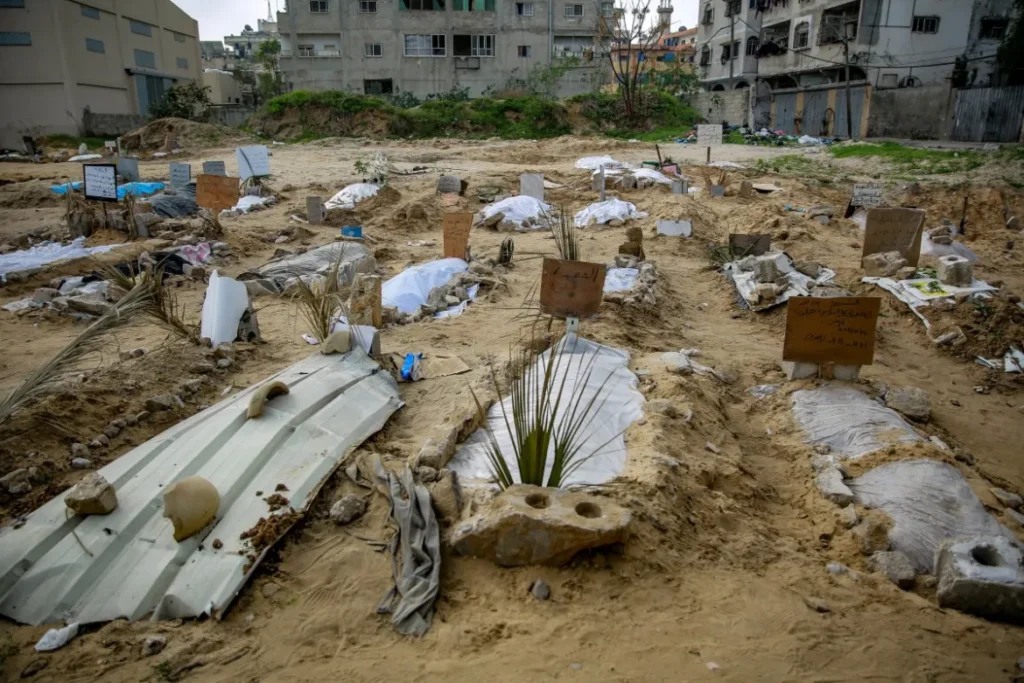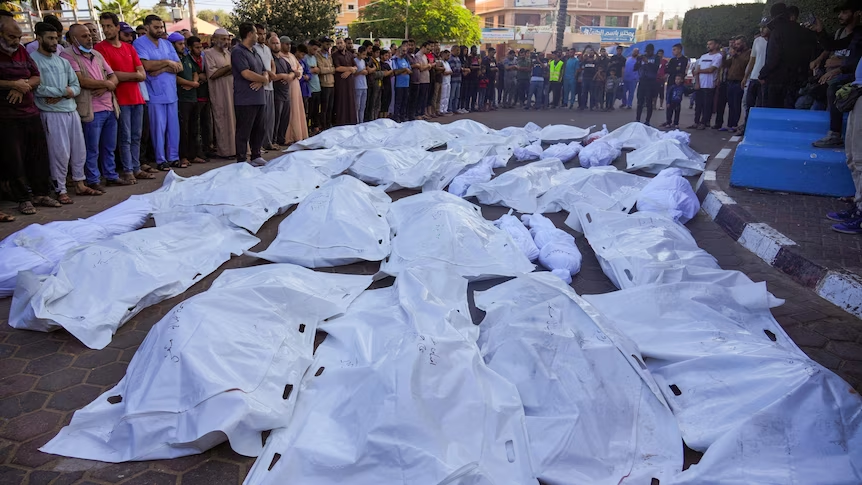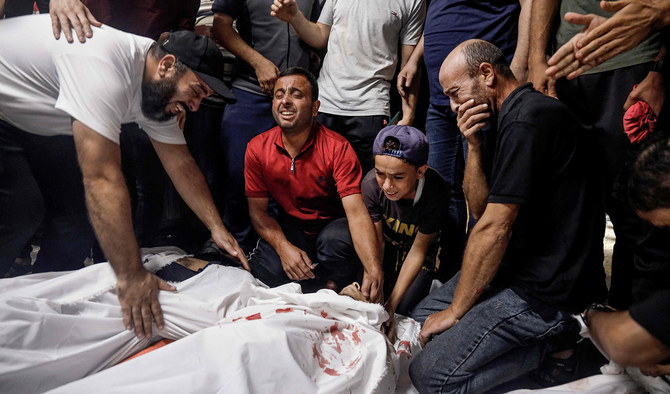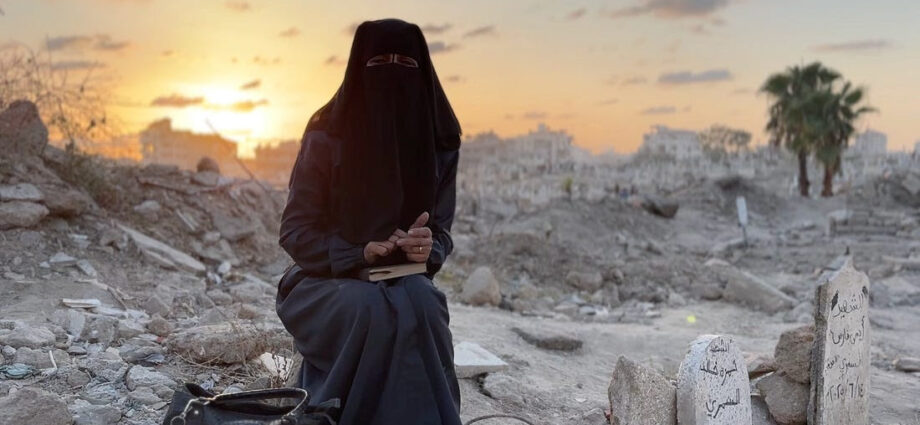An estimated 10,000 Palestinians killed by Israel remain buried under the rubble, according to Gaza’s Civil Defense
U.S. Vice President JD Vance said at a press conference in Israel on Tuesday. “That said, this is difficult. This is not going to happen overnight.
10,000 Palestinians bodies are a handful of Israeli captives killed in the war that have been the focus of the international media and U.S.
“Everyone came and no one knew where their child’s grave was. The remains are torn and people are dismembered and no one knows their child’s grave,”

GAZA CITY ( WEB NEWS )
After an Israeli airstrike on Vivian Al-Har’s home killed her entire family barely two weeks before the ceasefire went into effect during Israel’s concentrated military offensive on Gaza City, the disfigured and dismembered bodies of her husband, four daughters, son, and brother-in-law were pulled out of the ruins and buried. Her older son’s body remains trapped under the rubble.
“I am left alone, I am the only one remaining in the family. I have no sons, no daughters, no husband, no one,” Al-Har told Drop Site, weeping as she spoke. “There is no equipment. All the floors collapsed on my son; there were no tools and no one able to get him out. My son and my neighbor’s son are in the same house, and no one can reach them. As much as we tried to appeal to civil defense, there are no services. There is nothing in Gaza.”
An estimated 10,000 Palestinians killed by Israel remain buried under the rubble, according to Gaza’s Civil Defense, with Israel preventing the resources and equipment required to retrieve them. Among those bodies are a handful of Israeli captives killed in the war that have been the focus of the international media and U.S. and Israeli officials as part of the ceasefire agreement.

“It is a focus of everybody here to get those bodies back home to their families so they can have a proper burial,” U.S. Vice President JD Vance said at a press conference in Israel on Tuesday. “That said, this is difficult. This is not going to happen overnight. Some of these hostages are buried under thousands of pounds of rubble, some of the hostages nobody even knows where they are.” Vance did not mention the thousands of Palestinians also lying under the rubble. Nor did he mention the bodies of Palestinians buried in cemeteries that were bulldozed and destroyed by the Israeli military.
Vivian Al-Har at a cemetery in Gaza City located opposite the Al-Ahli Baptist Hospital that was destroyed by Israeli forces.
Al-Har said when she came to the cemetery opposite the Al-Ahli Baptist Hospital where the rest of her family is buried, she could hardly recognize it. “I came here to see my [other] son. I buried my son but I don’t know where he is. I kept searching,” Al-Har said. Around her, the graveyard was decimated, covered in broken tombstones and torn up earth. “Everyone came and no one knew where their child’s grave was. The remains are torn and people are dismembered and no one knows their child’s grave,” she said. “The dead are tormented and the living are tormented.”
Since the ceasefire went into effect, a total of 432 bodies have been retrieved across Gaza, according to the ministry of health.

“The issue of the missing persons under the rubble and retrieving the bodies of the martyrs is a very difficult and complex issue. This particular file is one of the most challenging tasks currently facing the Civil Defense,” Mahmoud Bassal, the spokesperson for Civil Defense told Drop Site. “We’re talking about 71,000 tons of waste scattered in different areas of the Gaza Strip,” he said. “The issue of heavy equipment is now a critical and very important matter to manage this, as well as the need for specialists, experts with the necessary skills and abilities to enter Gaza to assist the Civil Defense teams in carrying out this extremely difficult humanitarian task…If the situation remains as it is, under these current conditions, we will not be able to carry out retrieval operations. Even if there were a few pieces of heavy equipment, it would still take a long time to retrieve the bodies from under the rubble.”
In Gaza City on Monday, crowds in different neighborhoods gathered on large piles of rubble to try and break up huge slabs of broken concrete using little more than hammers in a search for the dead. One bloodied corpse was retrieved and carried in a blanket to a waiting ambulance.
Palestinians in Gaza City try to dig bodies out from under the rubble. October 20, 2025.
“This is an issue that truly shocked us—the double standards in the immense attention given by international organizations to search for the bodies of Israeli prisoners, while, in fact, there are 10,000 Palestinians missing under the rubble,” Bassal said. “This is a human being, and that is also a human being, both have the right to be buried in a humane way. But the Israeli occupation, it seems without a doubt, and the international system, too, have a problem with understanding that and with the concept of humanity.”
There are also an unknown number of Palestinians in Gaza who are simply missing, their families unaware whether they were killed or abducted by the Israeli military and imprisoned.
Amina Salem Abu Mousa’s 16-year-old son, Obeida, disappeared on May 29, when he went to a so-called aid distribution center run by the Gaza Humanitarian Foundation (GHF) near the Netzarim Corridor just south of Wadi Gaza and never returned.
“I haven’t heard anything, and no one has told me anything about him. I don’t know if he died, was martyred, imprisoned, arrested, or if he got shot and the dogs ate him. I don’t know. I just want someone to tell me something about him,” Abu Mousa told Drop Site. Over 2,600 Palestinians were killed by Israeli troops and American mercenaries at or near aid sites or truck convoys since the GHF began operating in Gaza in May. “He went because they said there would be aid, aid distribution. So, he took his ID and came to bring us the aid. We were starving, we didn’t have flour, we didn’t have food. Everything was closed, all the places were closed. There was nothing to eat, nothing at all,” she said. “He came, just like the others, like the young men, like the women, like the others who went. His brothers came back, and his neighbors came back, but he didn’t return. He still hasn’t returned.”

Since the ceasefire went into effect earlier this month and the GHF sites dismantled, Abu Mousa has been coming to the dusty Netzarim site every day to look for her son. “I come here just to see and smell his scent. To know where he is. I want someone to reassure me. He was the one who kept me company at home, helped me, brought me everything. I felt like the house was empty without him. My house feels empty without him,” she said. “There are eyewitnesses who said he was injured and the army took him. I want to know if the army took him and where they took him. Did they bury him? Did they detain him? I need to know. It is my right to know where my son is.”
Amina Salem Abu Mousa at a former GHF site near the Netzarim corridor where her son disappeared.
Israel has detained thousands of Palestinians from Gaza and the West Bank over the past two years, doubling the Palestinian prison population to over 11,000. As part of the ceasefire agreement, nearly 2,000 Palestinian captives—1,700 of them from Gaza—were released earlier this month in an exchange for the remaining 20 living Israeli captives. Israel has also returned the bodies of 165 Palestinians, according to the health ministry, in exchange for the bodies of dead Israeli captives. Some of the bodies bore signs of torture and execution, with their hands and feet still bound or eyes blindfolded. The bodies were sent back to Gaza with numbers instead of names, forcing the health ministry to publish photos of the decomposed corpses online for families to try and identify their loved ones. Only around two dozen have been identified so far. At least 135 of the bodies had been held in Sde Neiman, a prison camp in the Negev desert notorious for extreme abuse and torture of detainees, health officials told the Guardian. Leaked photos and testimonies from the site showed Palestinian detainees being held in cages, blindfolded and handcuffed, shackled to hospital beds and forced to wear diapers.
“This is how the bodies of Gaza’s prisoners were returned—blindfolded, bound like animals, and bearing signs of severe torture and burning,” Dr. Munir al-Bursh, director-general of the Health Ministry, wrote on social media. “They did not die naturally—they were executed while restrained, a war crime demanding an urgent international investigation and accountability for the perpetrators.”




